Clavius 
Move your mouse over the pictures to see the names of some of the features.
Clavius, the second largest crater on the visible hemisphere of the Moon (after Schickard), is circular and 231 Km
in diameter. Even for the Moon, this is an old crater, some 3,900 million years old. It is situated in the middle of the southern
highlands and is pock-marked with smaller craters within it. But where is its central peak? I don't know the answer to that, but the crater is relatively shallow for its size so it looks as though it has been filled up with something. It is older than many of the craters round about so maybe it is filled with ejecta from younger craters. Indeed there is a string of small craters in the southern part of the floor which point straight back to the Orientale basin, so ejecta from there certainly reached this far.
(Clavius was featured by Arthur C. Clarke in his book "2001 A Space Odyssey"
in which it was the site of the lunar base.)
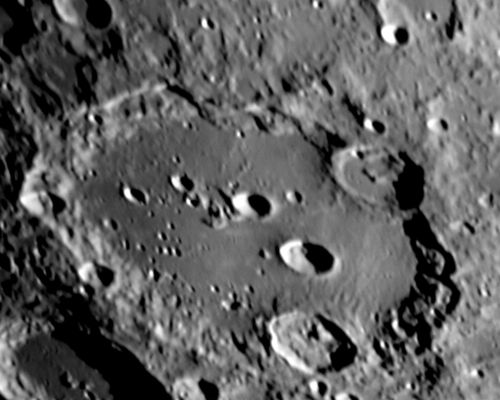 |
This picture was taken with a ToUcam attached to my 254mm LX200 with a ×2 adaptor lens on 1st March 2004, a night of exceptional seeing,
when the Moon was 9.7 days old.
Date and Time:
1st March 2004 21:41 UT
Phase: 59.7°
Libration: Latitude -5° 11', Longitude -3° 24'
Telescope: LX200 with ×2 lens
Camera: ToUcam 740K
Capture: K3CCDTools. High gamma, 1/50", 0% gain, 314 frames
Processing: Registax. 175 frames stacked. Wavelet 2-4 = 5, step = 2
|
|
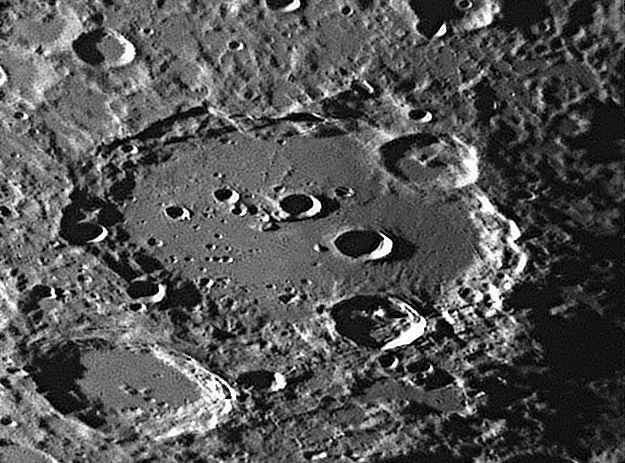 |
This picture was taken on 9th October 2020 with the same optics as above but with infra-red light when the seeing was not nearly so good, and the Moon was 21.4 days old. So the light is coming from the other direction compared to the image above
Note, Longomontanus is not in the picture; Longomontanus C is the crater where the L is.
Date and Time: 9th October 2020 05:23 UT
Phase: 279.4°
Libration: Latitude -1° 13', Longitude -6° 58'
Telescope: LX200 with ×2 lens
Camera: DMK 21AF04
Capture: IC Capture. 1/54", gain 1023, 1800 frames
Processing: Registax6. 39 alignment points, 400 frames stacked per alignment point.
Gaussian Wavelets Scheme 10.
Focus Magic 3 pixels.
|
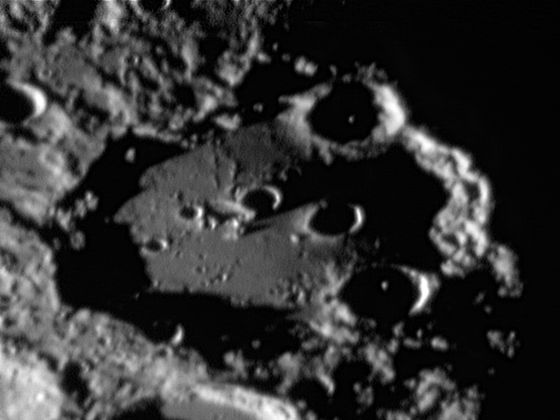 |
This picture was taken with a ToUcam attached to my 254mm LX200 with a ×2 adaptor
lens on 7th October 2004 when the Moon was 22.8 days old. Not only is the light from the other
side compared with the picture above, but the Sun was much lower in the lunar sky giving much
more exaggerated shadows. Clavius B, in Hatfield's atlas, is labelled Porter in the VMA. |
| Date and Time |
7th October 2004 03:37 UT |
| Camera |
ToUcam 740K |
| Telescope |
LX200 with ×2 lens |
| Capture |
K3CCDTools. High gamma, 1/50", 26% gain, 326 frames |
| Processing |
Registax. 93 frames stacked. Wavelet 1-3 = 10 |
| | |
|
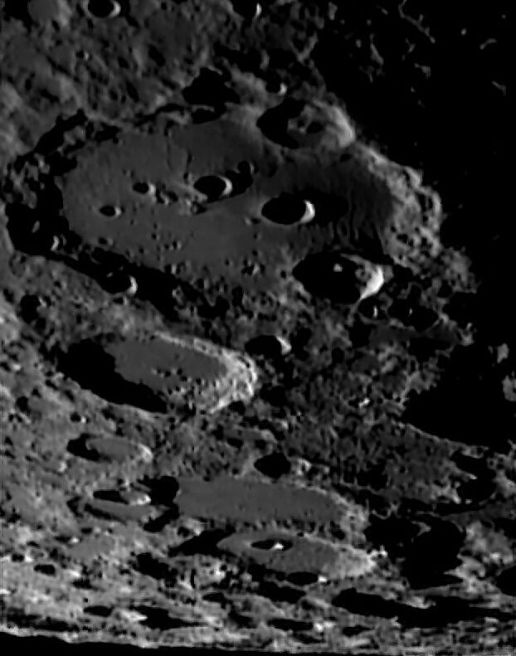 |
This picture was taken at almost exactly the same phase (22.9) as the picture above (I seem to like this phase!). This picture was taken in the early morning and the seeing was unusually steady so I used my ×2 converter lens and made this mosaic of Clavius and craters to the south. This my first experiment with a new piece of software called Focus Magic which is designed to correct pictures out of focus. My telescope at this focal length (5,000 mm) has poorer resolution than the camera, so the pictures may be considered as out of focus and Focus Magic does a good job.
The pictures were taken in the morning of 22nd October 2008 when the Moon was 22.9 days old. Here it is reduced by 20% to fit on the page. To see the picture at full scale, click on the image.
The scale markers are approximately 50 Km north and west. |
| Date and Time |
22nd October 2008 06:02 and 06:06 UT |
| Camera |
ToUcam 740K |
| Telescope |
LX200 with with ×2 teleadaptor lens |
| Capture |
K3CCDTools. Low gamma, 1/33", 25% gain, 693 frames |
| Processing |
Registax. 300 frames stacked. Histogram 0-190,
Focus Magic 6,100 |
| | |
|
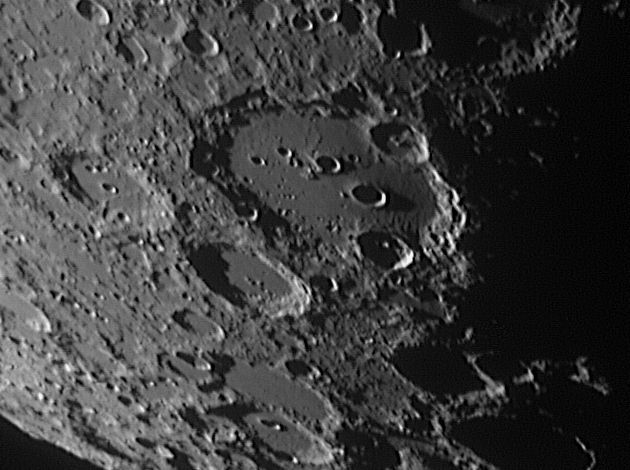 |
This picture was taken at almost exactly the same phase (22.7) as the two pictures above. The scene is quite similar to the picture immediately above but quite different to that in the picture above that. How can this be? The answer lies in the libration. In the upper picture, the libration in longitude was -1° 16', which means the Moon was tilted slightly to the east. In this picture, the libration was 4° 6', so here the Moon is tilted over 5° westward compared to the one above. In other words, Clavius was 5° further west relative to the terminator, and so the Sun was about 5° higher in the sky. Hence the shorter shadows. In the picture immediately above the libration in longitude was 5° 35' so the Moon was tilted even further to the west.
The scale markers are approximately 100 Km north and west. |
| Date and Time |
18th July 2006 08:06 UT |
| Camera |
ToUcam 740K |
| Telescope |
LX200 with with IR-pass filter |
| Capture |
K3CCDTools. Low gamma, 1/33", 28% gain, 461 frames |
| Processing |
Registax. 93 frames stacked. Wavelets 1 = 10, 2 = 5, gamma 1.4, histogram 30-255, brighness -10 |
| | |
|
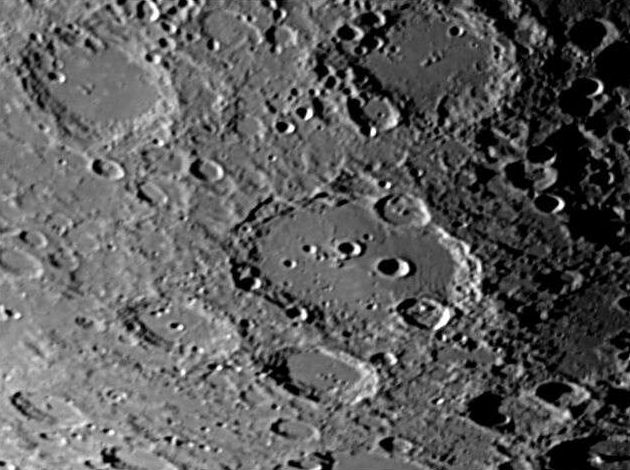 |
Again, this picture was taken at almost exactly the same phase (22.3) as the picture above and the lighting is different again. Here the libration in longitude was 7° 53', which means the Moon was tilted to the west almost as far as it ever can be. So here the Moon is tilted almost another 4° westward compared to the one above. In other words, Clavius was 4° further west relative to the terminator, and so the Sun about 4° higher in the sky, and the shadows are even shorter.
The scale markers are approximately 100 Km north and east. |
| Date and Time |
14th October 2006 03:37 UT |
| Camera |
Atik 1-HS |
| Telescope |
LX200 with with Nd filter |
| Capture |
K3CCDTools. 50% gamma, 1/50", 25% gain, 612 frames |
| Processing |
Registax. 93 frames stacked. Wavelets 1 = 10, 2 = 5, gamma 1.4, histogram 30-255, brighness -10 |
| | |
|
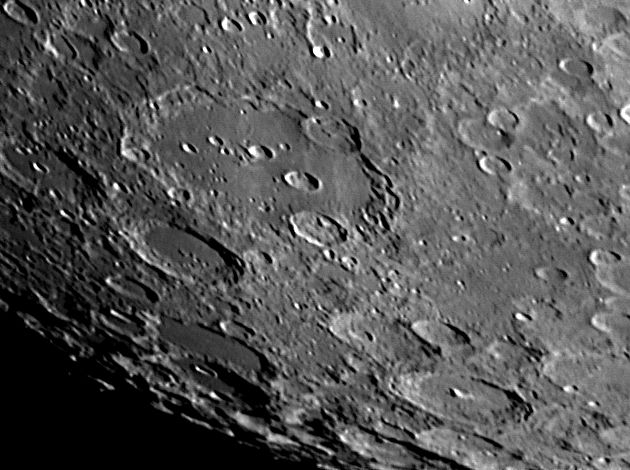 |
And here is a wider-angled picture showing Clavius in its setting in the southern highlands. More pictures at this and an even smaller scale can be seen here.
The scale markers are approximately 50 Km north and west.
The picture was taken on 12th November 2005 when the Moon was 11.4 days old. |
| Date and Time |
12th November 2005 21:03 UT |
| Camera |
ToUcam 740K |
| Telescope |
LX200 at prime focus |
| Capture |
K3CCDTools. Low gamma, 1/100", 9% gain, 416 frames |
| Processing |
Registax. 38 frames stacked. Wavelets 1 = 10, 2 = 5, histogram 0-200 |
| | |
|
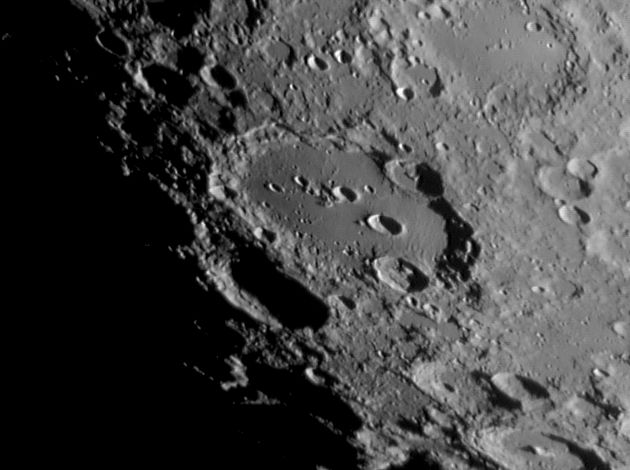 |
The same area imaged about two days earlier.
Clavius is a very shallow crater, only about 5 Km deep compared to its 231 Km diameter. This can be seen by looking at the shadow of the eastern wall and comparing that with the shadows in Porter and, for example, Clavius D. Clavius is an old crater (3,800 million years) and it may just be that it has been largely filled by material thrown out by the formation of later craters.
The scale markers are approximately 100 Km north and east.
The picture was taken on 10th December 2005 when the Moon was 9.8 days old. |
| Date and Time |
10th December 2005 17:11 UT |
| Camera |
ToUcam 740K |
| Telescope |
LX200 at prime focus and IR-pass filter |
| Capture |
K3CCDTools. High gamma, 1/33", 19% gain, 403 frames |
| Processing |
Registax. 106 frames stacked. Wavelets 1 = 10, histogram 20-255 |
| | |
|
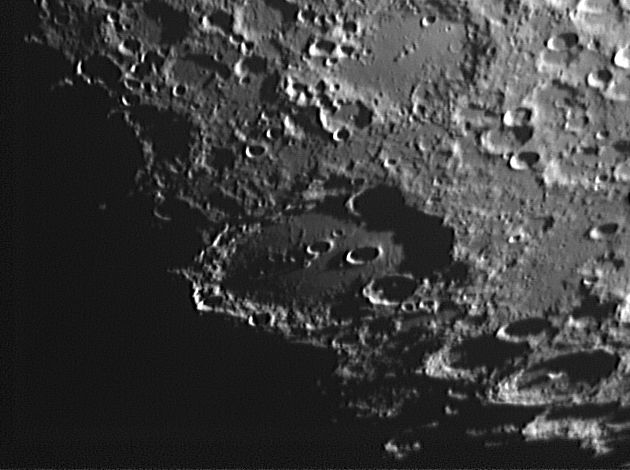 |
And this is the same area imaged only 0.8 day earlier than the one above. Notice how the shadows are much longer in this picture. This despite the fact that libration in Longitude had tipped the Moon almost 6° to the west in the earlier picture compared to this one. My calculations indicate that the Sun was only 4° lower in the sky in this picture than in the earlier one, showing how quickly the shadows move as the Sun rises over the lunar surface. Look particularly at Porter, completely filled by shadow here, and Rutherfurd where there appears to be a prominent feature on its western wall which is not visible in the earlier picture.
The scale markers are approximately 100 Km north and east.
The picture was taken on 5th June 2006 when the Moon was 9.0 days old. |
| Date and Time |
5th June 2006 18:07 UT |
| Camera |
ToUcam 740K |
| Telescope |
LX200 at prime focus and IR-pass filter |
| Capture |
K3CCDTools. Low gamma, 1/33", 22% gain, 614 frames |
| Processing |
Registax. 113 frames stacked. Wavelets 1 = 10, 2 = 5, histogram 10-200 |
Home Back to SW Quadrant More pictures










